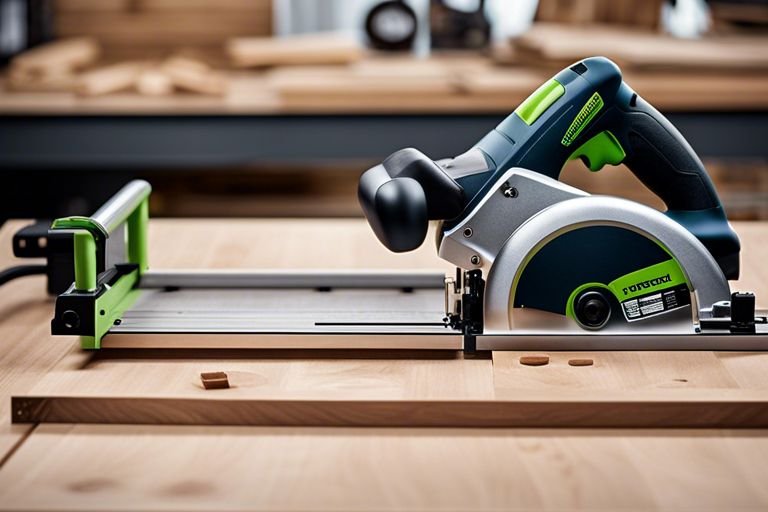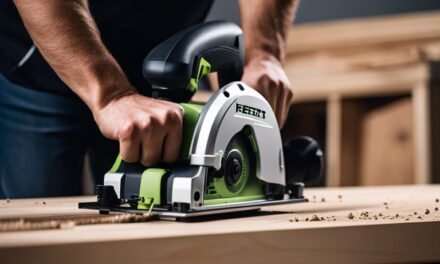There’s no need to fear making precise plunge cuts anymore because with the Festool TS 55 REQ Plunge Cut Track Saw, you can master this technique effortlessly. In this step-by-step guide, we will walk you through the process of perfecting plunge cuts using the Festool TS 55 REQ, equipping you with the skills and knowledge to achieve professional results in your woodworking projects.
Key Takeaways:
- Plunge cuts are versatile: Plunge cuts allow you to start your cut anywhere on the material without the need for pre-drilling, making them ideal for various woodworking projects.
- Use the Festool TS 55 REQ for precision: The Festool TS 55 REQ Plunge Cut Track Saw is a reliable tool for making accurate plunge cuts with its guide rail system, ensuring straight and clean cuts every time.
- Follow safety precautions: Prioritize your safety by wearing appropriate protective gear, securing your workpiece properly, and always familiarizing yourself with the tool’s manual and proper usage guidelines.

Understanding Plunge Cuts and Festool TS 55 REQ
What are Plunge Cuts?
The ability to make plunge cuts is an crucial skill for any woodworker or DIY enthusiast. Plunge cuts are cuts made by plunging the saw blade directly into the material, allowing you to start cutting in the middle of a workpiece without needing to make an edge cut first. This technique is often used for creating openings in the middle of a piece of wood or for cutting out shapes.
Overview of Festool TS 55 REQ Plunge Cut Track Saw
Plunge cutting can be made easy and precise with the Festool TS 55 REQ Plunge Cut Track Saw. This innovative tool is designed to make plunge cuts in a variety of materials with accuracy and efficiency. The track saw allows you to make straight, clean cuts without the need for measuring or marking your workpiece, making it ideal for both professionals and beginners.
With the Festool TS 55 REQ, you can adjust the cutting depth with precision, thanks to its accurate depth scale. This tool also features a splinter guard for tear-free cuts and a dust extraction system that keeps your work area clean. Whether you are working with wood, laminate, or other materials, this plunge cut track saw is a versatile and reliable tool for your workshop.
Types of Plunge Cuts
Clearly, understanding the different types of plunge cuts you can make with your Festool TS 55 REQ Plunge Cut Track Saw is necessary for mastering this versatile tool. Here are the various types of plunge cuts you can perform:
| Straight Plunge Cuts | Beveled Plunge Cuts |
| Compound Plunge Cuts | Curved Plunge Cuts |
Straight Plunge Cuts
An necessary plunge cut that you will commonly make is the straight plunge cut. This type of cut is perfect for tasks such as cutting sheet materials, creating grooves, and starting cuts in the middle of a workpiece. With the Festool TS 55 REQ, you can easily make precise and smooth straight plunge cuts.
Beveled Plunge Cuts
Anytime you need to make angled cuts, beveled plunge cuts come into play. These cuts are commonly used for tasks like cutting beveled edges on doors, creating chamfers, or cutting angles on furniture pieces. With the Festool TS 55 REQ, you can adjust the bevel angle to make precise beveled plunge cuts effortlessly.
Plunge. With the Festool TS 55 REQ, you can easily adjust the bevel angle to make accurate beveled plunge cuts for your woodworking projects.
Compound Plunge Cuts
An advanced type of plunge cut is the compound plunge cut, which involves making both beveled and angled cuts simultaneously. This type of cut is ideal for complex woodworking projects where multiple angles are needed. With the Festool TS 55 REQ, you can achieve compound plunge cuts with ease and precision.
Straight. The Festool TS 55 REQ’s capabilities allow you to make compound plunge cuts accurately and efficiently, expanding your possibilities for intricate woodworking projects.
Curved Plunge Cuts
Little with a steady hand and the Festool TS 55 REQ, you can also make curved plunge cuts. These cuts are perfect for tasks like cutting arcs, circles, or other curved shapes in various materials. Whether you’re working on custom furniture pieces or intricate designs, the Festool TS 55 REQ ensures smooth and precise curved plunge cuts.
Plunge. The Festool TS 55 REQ provides the control and precision you need to execute curved plunge cuts with ease, giving your woodworking projects a professional finish.
Essential Tips for Mastering Plunge Cuts
Many beginners struggle with plunge cuts, but with the right techniques and tools, you can master this skill. Here are some imperative tips to help you improve your plunge cutting abilities:
- Assuming you are looking to achieve clean and precise cuts, choosing the right blade for your Festool TS 55 REQ plunge cut track saw is crucial. Make sure to use a high-quality, sharp blade that is suitable for the material you are cutting.
Setting Up Your Festool TS 55 REQ
Some key steps in setting up your Festool TS 55 REQ for plunge cuts include adjusting the depth of the blade to match the thickness of your material and ensuring that the track is securely in place before starting the cut. This ensures accuracy and safety when performing plunge cuts.
Another important factor to consider when setting up your Festool TS 55 REQ is making sure that the anti-splinter guard is in place to prevent splintering along the cut line. This will help you achieve clean and professional-looking cuts every time.
Maintaining Control and Stability
Little adjustments can make a big difference in maintaining control and stability during plunge cuts. Make sure you have a firm grip on the saw and keep it steady as you engage the blade into the material. This will help you achieve smoother and more accurate cuts.
It’s also important to pay attention to your body positioning and the pressure you apply to the saw. By keeping a steady pace and applying consistent pressure, you can maintain control and stability throughout the cut, resulting in cleaner and more precise plunge cuts.
Managing Dust and Debris
For a cleaner and healthier work environment, it’s imperative to manage dust and debris while using your Festool TS 55 REQ plunge cut track saw. Connect a dust extraction system to the saw to capture dust at the source and minimize airborne particles. This not only improves visibility and accuracy but also protects your lungs from harmful dust.
Plus, regularly cleaning the saw and changing the dust collection bag will help maintain the effectiveness of the dust extraction system and ensure optimal performance of your Festool TS 55 REQ plunge cut track saw. By keeping your workspace clean and free of debris, you can work more efficiently and safely.
Step-by-Step Guide to Making Plunge Cuts with Festool TS 55 REQ
All Festool TS 55 REQ track saw is a powerful tool that allows you to make precise plunge cuts effortlessly. If you are wondering about the capabilities of the Festool 55 track saw, you can find more information in this article on Can I use a Festool 55 track saw to cut 1-1/2 thick red oak?.
Preparing Your Material
Your first step in making plunge cuts with the Festool TS 55 REQ is to prepare your material. Ensure that the material is properly secured and supported to prevent any movement during the cutting process. Double-check the measurements and marks to ensure accuracy when making your plunge cut.
Aligning the Track and Saw
Assuming you have your material ready, the next step is to align the track and saw. It is crucial to make sure that the track is securely in place and aligned with your cut line. Check that the saw is properly seated on the track before making your plunge cut. It is recommended to practice a few times without powering the saw to ensure the alignment is perfect.
It is imperative to take your time aligning the track and saw correctly to prevent any errors in your cut. The Festool TS 55 REQ has an anti-tilt feature that helps maintain stability and accuracy during the cutting process.
Making the Cut
If you have completed the preparation and alignment steps, you are ready to make the plunge cut with the Festool TS 55 REQ. Start the saw away from the material, then gently lower it into the material while applying light pressure. Allow the saw to reach full speed before advancing it along the track. Make sure to follow through the cut smoothly and steadily for a clean and precise plunge cut.
Another imperative tip for making plunge cuts is to use slow and consistent forward motion to maintain control over the saw. This will help you achieve clean and accurate cuts, especially when working with delicate materials or intricate designs.
Tips for Smooth and Accurate Cuts
Making plunge cuts with the Festool TS 55 REQ can be a breeze if you follow these tips for smooth and accurate cuts:
- Make sure the blade is sharp and suitable for the material you are cutting.
- Always wear safety gear, including goggles and ear protection, when operating the saw.
This step-by-step guide will help you master the art of plunge cuts with the Festool TS 55 REQ, allowing you to achieve professional results in your woodworking projects. Thou should always practice on scrap material before attempting plunge cuts on your final workpiece to ensure precision and accuracy.
Critical Factors to Consider When Making Plunge Cuts
Once again, when mastering the art of plunge cuts with the Festool TS 55 REQ Plunge Cut Track Saw, there are several critical factors you need to consider to ensure precision and accuracy in your cuts. Here are some key points to keep in mind:
- Material Thickness and Type: One of the most important factors to consider when making plunge cuts is the thickness and type of material you are working with. Different materials may require adjustments to the saw blade depth or speed to achieve optimal results. For detailed information on choosing the right blade for your material, check out this Festool – TS 55 EQ Circular Saw review.
Material Thickness and Type
One important thing to keep in mind is the thickness and type of material you are cutting. The depth of the plunge cut needs to be adjusted according to the material you are working with. Knowing the material properties will help you determine the appropriate blade depth and speed for a clean and accurate cut.
- Saw Blade Selection: Cuts made with a plunge cut track saw are only as good as the blade that’s doing the work. Choosing the right saw blade for your specific cutting needs is crucial for achieving clean cuts without splintering or tear-out.
Saw Blade Selection
Cuts made with a plunge cut track saw are only as precise as the blade being used. It is important to select the appropriate saw blade based on the material you are cutting and the type of cut you want to achieve. Festool offers a variety of high-quality blades designed for different materials and cutting requirements that can help you achieve professional results.
Some other important factors to consider when selecting a saw blade include the number of teeth, tooth configuration, and blade diameter. It is important to choose a blade that is suitable for the material you are working with to ensure clean and accurate cuts.
Track Alignment and Stability
Some of the important aspects of making plunge cuts with a track saw include ensuring proper track alignment and stability. Adjusting the track to align accurately with your cut line and securing it firmly in place will help prevent any deviations during the cutting process.
Critical to the success of your plunge cuts is having the track properly aligned and secured to ensure straight and precise cuts. Whether you are making long cuts or intricate shapes, maintaining track alignment and stability is crucial for achieving professional results.
User Experience and Skill Level
Thickness also plays a significant role in making plunge cuts with precision and accuracy. Thicker materials may require adjustments in blade depth and cutting speed to achieve the desired outcome. Understanding how different materials react to plunge cuts and practicing on scrap pieces can help you develop the skills needed for successful cuts.
Pros and Cons of Using Festool TS 55 REQ for Plunge Cuts
Despite the numerous benefits of using the Festool TS 55 REQ plunge cut track saw for your woodworking projects, it is important to consider the advantages and limitations of this tool before making a purchase decision. Below is a breakdown of the pros and cons of using the Festool TS 55 REQ:
| Advantages | Limitations and Disadvantages |
| Accurate plunge cuts | Higher price compared to other plunge cut saws |
| Smooth cutting performance | Limited cutting depth compared to some circular saws |
| Easy to use and maneuver | May require additional accessories for certain applications |
| Compatible with Festool guide rails for precision | Can be heavy for extended use without support |
Advantages of Festool TS 55 REQ
Now, let’s focus on the advantages of using the Festool TS 55 REQ plunge cut track saw for your woodworking projects. Firstly, this tool enables you to make precise plunge cuts with ease, ensuring clean and accurate results for your various cutting tasks. Additionally, the Festool TS 55 REQ’s smooth cutting performance provides you with professional-looking finishes on your workpieces.
Limitations and Disadvantages
Cuts made with the Festool TS 55 REQ are smoother, cleaner, and more accurate than those done with standard circular saws. However, it is necessary to acknowledge the limitations and disadvantages of using this tool. One limitation is that this saw may be heavier compared to other plunge cut saws, making it less comfortable for prolonged use without additional support.
It is important to weigh the pros and cons of using the Festool TS 55 REQ plunge cut track saw to determine if it aligns with your woodworking needs and preferences.
Summing up
With these considerations in mind, you are now equipped with the knowledge and skills necessary to master plunge cuts with the Festool TS 55 REQ Plunge Cut Track Saw. By following the step-by-step guide provided, you can confidently and accurately make plunge cuts in a variety of materials with precision and ease.
Remember to always prioritize safety by using the appropriate safety gear and following the manufacturer’s instructions. With practice and patience, you can become proficient in using the Festool TS 55 REQ Plunge Cut Track Saw to achieve professional results in your woodworking projects. Happy cutting!
Q: What makes the Festool TS 55 REQ Plunge Cut Track Saw unique?
A: The Festool TS 55 REQ Plunge Cut Track Saw is known for its precision, versatility, and ease of use. It features a plunge cut mechanism that allows you to make accurate cuts right in the middle of a workpiece, without the need for pre-drilling or starting from the edge.
Q: How do you set up the Festool TS 55 REQ Plunge Cut Track Saw for a plunge cut?
A: To set up the Festool TS 55 REQ for a plunge cut, first attach the saw to the guide rail. Set the depth of cut to the desired measurement, position the saw on the workpiece where you want to make the cut, line up the blade with your cutting line, and then plunge the saw down to start cutting.
Q: What are some tips for mastering plunge cuts with the Festool TS 55 REQ Plunge Cut Track Saw?
A: To master plunge cuts with the Festool TS 55 REQ, practice on scrap material first to get a feel for the saw’s plunge mechanism. Always ensure the workpiece is properly supported and secured before making a cut. Take your time and let the saw do the work, avoiding forcing it through the material. Use a sharp blade and keep the saw clean for optimal performance.





